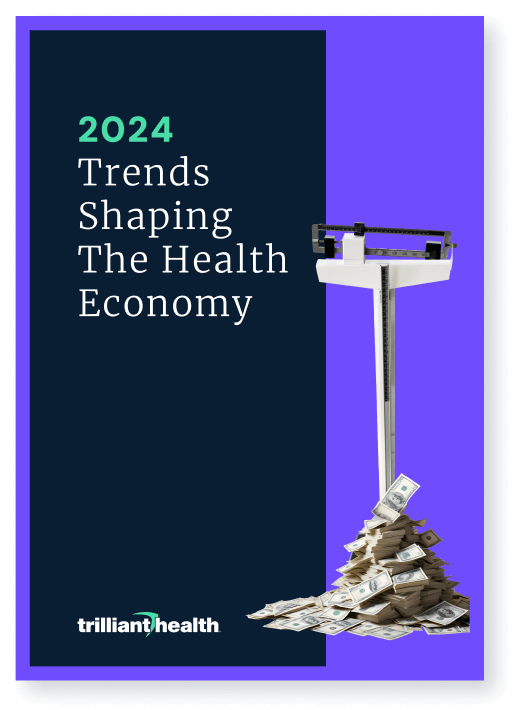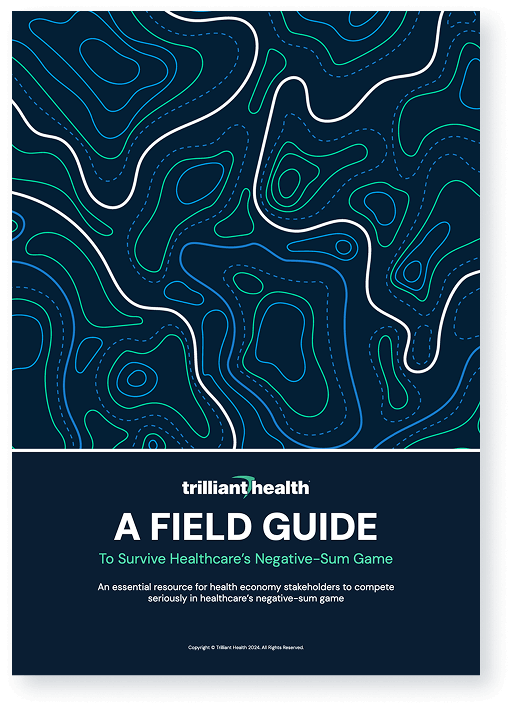Counterpoint
Trilliant Health | August 22, 2022HFMA Voices in Healthcare Finance Podcast | Above and beyond in the Mile High City: Insights about the future of healthcare from HFMA’s 2022 Annual Conference
An excerpt from a conversation that originally aired on Voices in Healthcare Finance, a podcast from HFMA.
[4 MIN READ | 30 MIN LISTEN]
Trilliant Health’s SVP of Product Strategy, Jason Nardella, spoke with Erika Grotto, HFMA's Senior Editor, on the Voices in Healthcare Finance podcast about pandemic deferred care.
Note: The Q&As below are paraphrased from the conversation.
Grotto: Since the onset of the pandemic, deferred care has emerged as one of the most significant challenges in healthcare, and several times in Denver I found myself in conversations with people about the best ways to get patients back in for the care they need. One of those people was Jason Nardella, senior vice president of product strategy at Trilliant Health. We talked about where things are today and his thoughts about improvements for the future.
We’ve been talking about deferred care since pretty much the beginning of the pandemic. Some of it has picked back up. We’re not quite to 2019 levels. So let’s talk for a minute just to lay the groundwork—where do we stand today? Do you have any statistics on that?
Nardella: I think the broader view of health systems now in 2022 is, we’re at the end of what’s seeming like a business cycle where all of our payers to pharma companies to medical device—everybody has made a ton of money and it’s the hospitals that are sort of left behind here. A lot of it has to do with meeting that patient demand and making sure the patients can come back in. As far as delayed care, we’ve seen across the board, and I know you’ve done a segment on this earlier around cancer screenings, and all of them have been down since 2019 levels and they’re even going down from 2022 to 2021 as well. The only areas where we seem to get some bounceback is actually some of the easier colorectal screenings that can actually be done at home. And those have been sort of a great success, but that has been the least amount of decline year over year from a cancer screening point of view. There is a bright spot, though. I think PCP utilization in females age 20-49 is the only bright spot where we’ve actually seen an increase in utilization or an increase of engagement with that patient population in 2020 and 2021 compared even to 2019 levels.
Grotto: Why do you think that is? Is it that healthcare organizations are better at engaging people in that population, or are those people just more engaged already?
Nardella: My fiancé would say that it’s because females take care of themselves a lot better than men, and I would tend to agree with her in a lot of those situations, but the complexity and I think the willingness to sort of take care of themselves proactively, especially in that age group, has been sort of demonstrated across not only PCPs but with OBs. And they’re also the group that is more likely than not to participate in behavioral health too. And so there is very much a willingness to continue to see the doctor and to take care of oneself and to notice the fluctuations and try to take care of themselves proactively knowing that we’re not all invincible and we can’t stay healthy forever.
Grotto: How do you think we’ll get where we’re going? With some of the changes that have come about as the result of the pandemic, we made some adjustments because of safety when we needed to, but some of the changes that have been made have been kind of great, so where do you think we’re going to land in the end and how do you think we’re going to figure it out and strike that balance?
Nardella: I hope that we’re all within sort of an operations side of things, finance side of things, figuring out parts of the necessary either paperwork or prework or things that always typically happen within the doctor’s office or within the waiting room. Thinking about ways to handle that more digitally and a lot more conveniently for folks. I think what you outline there is what a lot of folks are saying was preventing them from getting back into healthcare, which is like, “I don’t actually want to be around a bunch of sick people when there’s a highly contagious airborne virus floating around everywhere. I would rather just be by myself or in a safer area and then go in whenever I need to and then come out again.” That idea is something we’ve been kicking around and what we’ve started to think of is, how do the providers actually break out of their doctor’s offices. Have they actually go start to see more people? Do we do more work fairs? Do we have more mobile clinics that we can actually go to the people, have them just come in and be seen, engage in healthcare, start to get their medical plans again, and then be able to have some semblance of a start back to sort of normalcy at least from seeking healthcare. You know, going to the patients, kind of creating that environment where it is convenient and safe for them is really going to be the bar that everybody’s got to hop over here. Telehealth is one way of doing it again, but it does not take the place of seeing a doctor in person, actually having that conversation, actually seeing the nurse when you need to. And actually a survey that came out from the University of Chicago, one thing that has not changed over time is the people’s trust in their providers and in their nurses. Both before and after the pandemic, more than 80% of all survey respondents said they have high trust in both their doctors and their nurses. Compare that to hospitals and health systems, which have actually gone down over time, around 72% for hospitals, 64% for health systems. It’s the doctors who are going to be able to pull us out of this. It’s the nurses that are going to be able to help engage folks and get them more comfortable to come back into healthcare and really prevent what could be a really kind of terrible sort of boomerang wave in the future if we don’t start caring for ourselves, we don’t start getting back on that preventive medicine. Everybody’s going to become more acute and a lot more of the diseases and the things that could be caught early on are going to manifest and get a lot worse, which makes it harder to treat in a community and also worse off for all of us consumers out there.
Grotto: Do you think at this point that people are afraid to go in? Are they trying to avoid the risk of getting sick at this point in 2022? Or is it something else?
Nardella: As somebody who flies a fair amount, I think that there is a lot of the population or a significant part of the population who still really is trying to avoid getting COVID at all risks. They could be sick, or there’s sort of a genuine fear of COVID. I think that’s certainly an issue. I think personally for a lot of other folks, it is getting back into the habit of things. A story that I have is that I moved from Boston to Minneapolis and I just recently got a new dentist. And it’s not because I don’t like the dentist. It’s not because I didn’t think I needed the dentist. It’s because I just didn’t have that relationship. I didn’t have somebody that I could go to that knew my medical records and that I could get in there. It’s the habitual part of self-care that I think makes it really work, and because we’ve had a year, two year stint where we’ve broken out of a lot of our habits both good and bad, that is a big real hangup to people coming back and utilizing healthcare the same way they did either in 2018 or 2019.
Grotto: Well, it will be interesting to see what comes in the next handful of years, though I know being at Annual Conference amongst all these eager HFMA members, I’m hopeful that there are people who are working hard to improve things. So Jason Nardella, thank you so much for joining me.
Nardella: Thank you, Erika.
Grotto: Trilliant Health's proprietary analytics platform produces a comprehensive understanding of local market dynamics providing exponentially better data insights to maximize returns from growth strategies. Visit trillianthealth.com for more.
- Podcast
























